
The Mini is a small, two-door, four-seat car produced by the British Motor Corporation (BMC) and its successors, from 1959 until 2000. Minus a brief hiatus, original Minis were built for four decades and sold during five, from the last year of the 1950s into the last year of the 20th century, over a single generation, as fastbacks, estates, and convertibles.

The Renault Trafic is a light commercial van produced by the French automaker Renault since 1980. It has also been marketed as the Fiat Talento, the Nissan NV300, the Nissan Primastar and the Mitsubishi Express. Until 2018, it was also sold as the Opel/Vauxhall Vivaro by Opel and its associated company Vauxhall. From early 2022 onwards, the van is also marketed by Renault Trucks as the Renault Trucks Trafic.
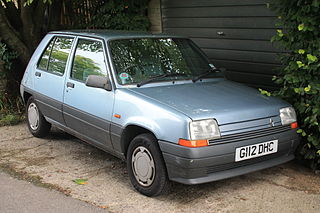
The Renault 5 is a five-passenger, three or five-door, front-engine, front-wheel drive hatchback supermini manufactured and marketed by the French automaker Renault over two generations: 1972–1985 and 1984–1996.

The Renault 9 and Renault 11 are small family cars produced by the French manufacturer Renault from 1981 to 1989 in saloon and hatchback configurations — both were styled by the French automobile designer, Robert Opron.
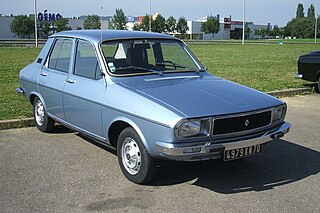
The Renault 12 is a mid-size family car introduced by French automaker Renault at the Paris Motor Show in October 1969 and produced in France until 1980. Available as a saloon (Berline) and estate (Break), it was also produced under licence in many countries around the globe into the early 21st century.

Front-wheel drive (FWD) is a form of engine and transmission layout used in motor vehicles, in which the engine drives the front wheels only. Most modern front-wheel-drive vehicles feature a transverse engine, rather than the conventional longitudinal engine arrangement generally found in rear-wheel-drive and four-wheel-drive vehicles.
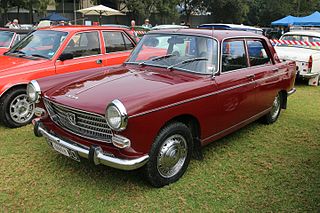
The Peugeot 404 is a large family car produced by French automobile manufacturer Peugeot from 1960 to 1975. A truck body style variant was marketed until 1988. Styled by Pininfarina, the 404 was offered initially as a saloon, estate, and pickup. A convertible was added in 1962, and a coupé in 1963. The 404 was fitted with a 1.6 litre petrol engine, with either a Solex carburetor or Kugelfischer mechanical fuel injection or a 1.9 litre diesel engine available as options. Introduced at the Paris Motor Show as an option was the inclusion of a 3-speed ZF automatic transmission, similar to the unit already offered on certain BMW models, as an alternative to the standard column-mounted manual unit.

BMC ADO17 is the model code used by the British Motor Corporation (BMC) for a range of cars in the European 'D' market-segment of larger family cars, manufactured from September 1964 to 1975. The car was initially sold under the Austin marque as the Austin 1800, then by Morris as the Morris 1800, and by Wolseley as the Wolseley 18/85. Later, with a 2.2 L engine, also as the Austin 2200, Morris 2200 and Wolseley Six. Informally, because of the car's exceptional width and overall appearance, these cars became widely known under the nickname "landcrab"
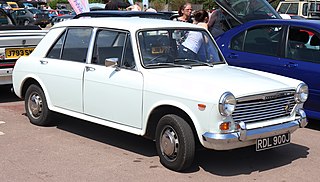
The BMC ADO16 is a range of small family cars built by the British Motor Corporation (BMC) and, later, British Leyland. Launched in 1962, it was Britain's best-selling car from 1963 to 1966 and from 1968 to 1971. The ADO16 was marketed under various make and model names; however, the Austin 1100 and Morris 1100 were the most prolific of all the ADO16 variants. The car's ubiquity at the height of its popularity led to it simply being known as the 1100 (eleven-hundred) in its home market. Also made with a 1275cc engine, it was then typically called 1300.

The MGB is a two-door sports car manufactured and marketed from 1962 until 1980 by the British Motor Corporation (BMC), later the Austin-Morris division of British Leyland, as a four-cylinder, soft-top sports car. It was announced and its details first published on 19 September 1962. Variants include the MGB GT three-door 2+2 coupé (1965–1980), the six-cylinder sports car and coupé MGC (1967–1969), and the eight-cylinder 2+2 coupé, the MGB GT V8 (1973–1976).

The Austin Cambridge is a medium-sized motor car range produced by the Austin Motor Company, in several generations, from September 1954 through to 1971 as cars and to 1973 as light commercials. It replaced the A40 Somerset and was entirely new, with modern unibody construction. The range had two basic body styles with the A40, A50, and early A55 using a traditional rounded shape and later A55 Mark IIs and A60s using Pininfarina styling.

The Wolseley 24/80 is an automobile produced by British Motor Corporation (Australia) from May 1962 to October 1965, based on the British four-cylinder Wolseley 15/60 model.

The Ford Escort is a small family car that was manufactured by Ford of Europe from 1968 until 2000. In total there were six generations, spread across three basic platforms: the original, rear-wheel-drive Mk.1/Mk.2 (1968–1980), the "Erika" front-wheel-drive Mk.3/Mk.4 (1980–1992), and the final CE-14 Mk.5/Mk.6 (1990–2002) version. Its successor, the Ford Focus, was released in 1998, but the final generation of Escort was phased out gradually, with the panel van version ending production in 2002 in favour of the Ford Transit Connect.
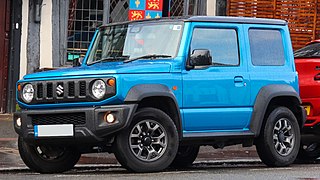
The Suzuki Jimny is a series of four-wheel drive off-road mini SUVs, manufactured and marketed by Japanese automaker Suzuki since 1970.

The Alpine A110 is a sports car produced by French automobile manufacturer Alpine from 1963 to 1977. The car was styled as a "berlinette", which in the post-WWII era refers to a small enclosed two-door berline, better-known as a coupé. The Alpine A110 succeeded the earlier A108. The car was powered by a succession of Renault engines. A car also named Alpine A110 was introduced in 2017.

The Fiat 1300 and Fiat 1500 are a series of front-engine, rear-drive automobiles manufactured and marketed by Fiat from 1961 to 1967, replacing the Fiat 1400 and Fiat 1200 coupé, spyder and cabriolet. The 1300 and 1500 were essentially identical to each other except for their engine displacement, as indicated by their model names, and were offered in sedan/saloon, station wagon, convertible and coupé body styles which shared little mechanically with the other body styles except the 1500 engine.

The DKW Schnellaster, also known as the DKW F89 L, was a van produced by DKW from 1949 to 1962. Alongside the DKW F89 passenger car, it was the first vehicle to be manufactured by the new Auto Union conglomerate in Ingolstadt following the re-establishment of the business in West Germany. The model name Schnellaster translates from German to English as Rapid Transporter.

Revoz is Slovene car manufacturer based in Novo Mesto and the subsidiary company of French car manufacturer Renault. It is the only automaker in the country and one of its largest exporters. The company was established in June 1988 as a joint venture between Renault and Industrija Motornih Vozil. In 2004, it became a wholly owned subsidiary of Renault.

The Renault 2,500 kg and the Renault Galion were truck/vans with a 2.5-tonne carrying capacity manufactured by Renault between 1947 and 1957 and then by its subsidiary Saviem between 1957 and 1965.
The Austin D and K series engines are a straight-six engine made by the British Austin Motor Company between 1939 and 1968. It was developed initially for the lorry market; but was used in a number of automobiles in its later life. It was an overhead valve non-crossflow cylinder head design. Both block and head were made out of cast iron. All engines had a forged four main bearing crankshaft.





















